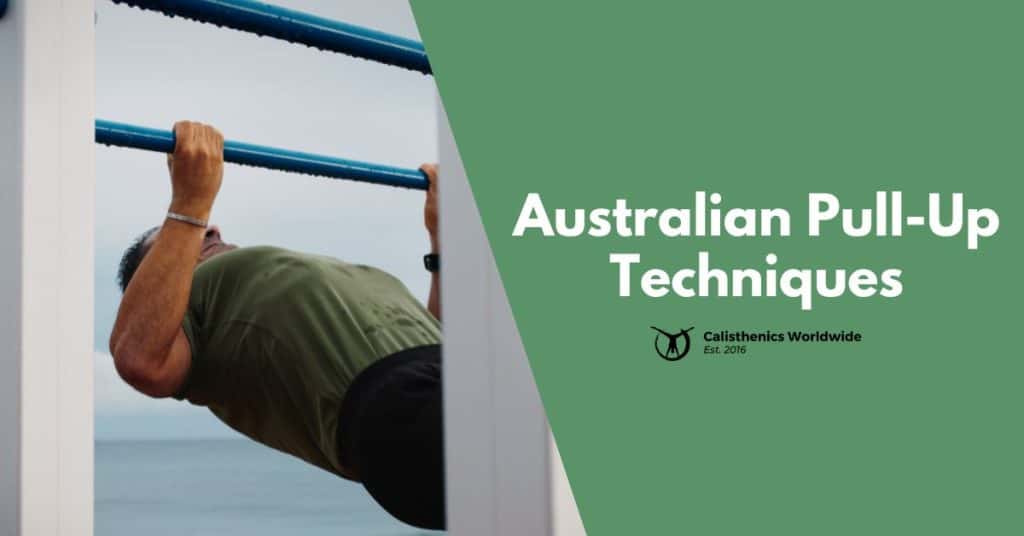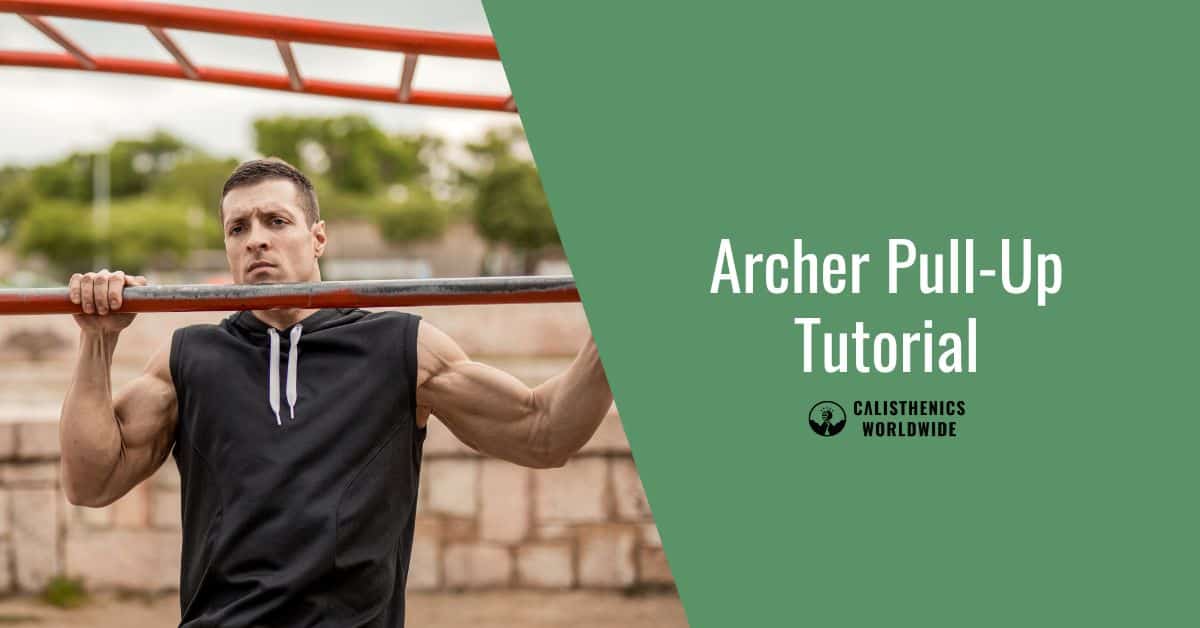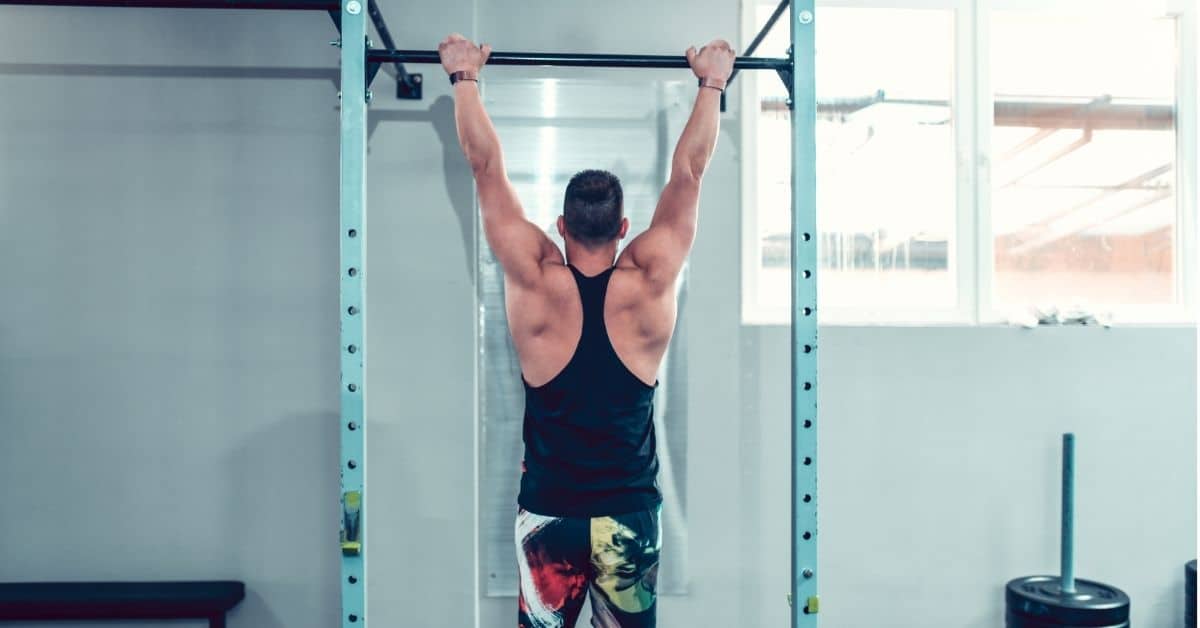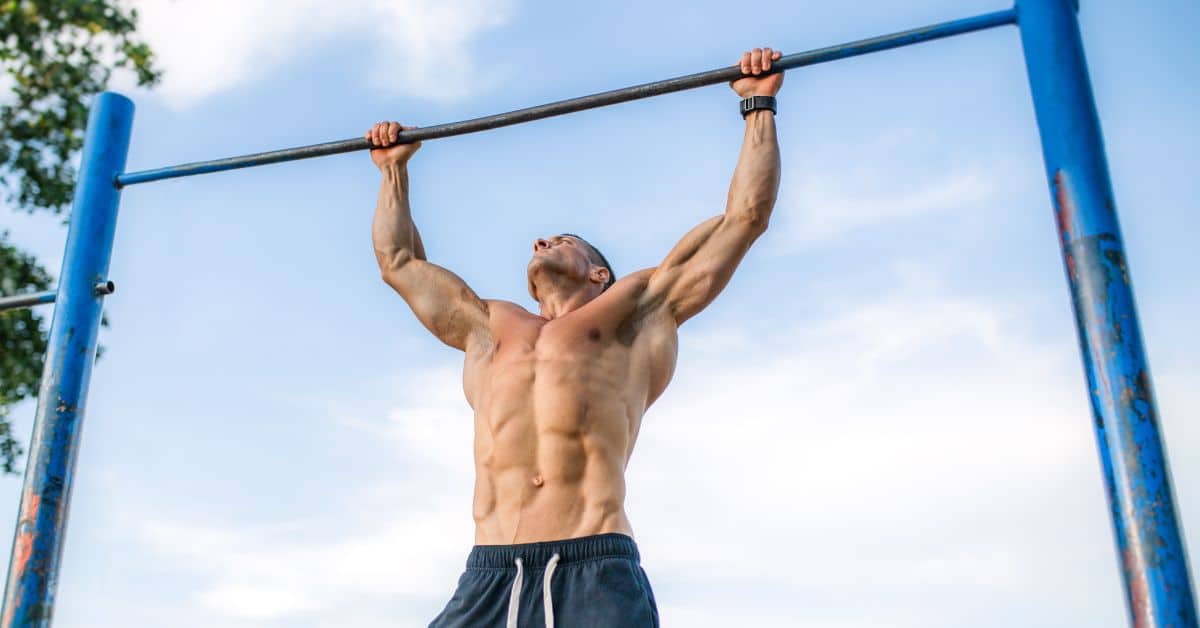- What is an Australian Pull-Up?
- How to do the Australian Pull-Up
- Muscles Worked with the Australian Pull-Up
- Benefits of the Australian Pull-Up
- 10 More Australian Pull-Up Variations
- Bodyweight Rows at Home
- Best Australian Pull-Up Bar
- What is the difference between the Australian Pull-Up and a Regular Pull-Up?
- Conclusions about the Australian Pull-Up
- Frequently Asked Questions About Australian Pull-Ups
The Australian Pull-Up, also called Inverted Row or Bodyweight Row is an important compound exercise but also steppingstone technique many beginner Calisthenics practitioners will acquire. This technique can be as easy as leaning back slightly and coming back up, to the very hard Elevated Australian Pull-Up where you’re pulling up against a decline (inverted incline). With the potential to shape you up from your beginner blubber to a strong, endurant and toned body, it is time to learn all about the Inverted Body Row. By the end of this article, you will know what the Australian Pull-Up is about and about its most effective variations and additions.
What is an Australian Pull-Up?
The Australian Pull-Up is another name for the Inverted Row or Bodyweight Row. We don’t know exactly where the name came from, but it might have to do with your position “down-under” the bar while you perform the technique. Key point we want to focus on is the technique, though. As a row, you’re making a ‘rowing’ motion, or moving your arms back and forth parallel horizontally to which way you’re facing (front to back and returning). This is similar too, but different from a proper Pull-Up where you’re moving your arms parallel to your body vertically (up and down).
Both with the proper Pull-Up and the Australian Pull-Up, your hands are holding on to a fixed point, so the generated force is moving your body. The consequence is that your arm, back and shoulder muscles experience resistance from your bodyweight in much the same way. However, the Bodyweight Row is a whole lot easier to perform than a proper Pull-Up.
How to do the Australian Pull-Up
This is how you do a basic, proper Australian Pull-Up.
- Lay beneath a low bar or other suitable object which can hold your weight. Your shoulders should be positioned straight under this bar.
- Grab the bar at shoulder width, the bar should be low enough that you can hold them, while your feet still touch the ground but you’re also at an incline while keeping your body straight. The steeper the incline, up to almost completely horizontal, the harder the exercise.
- Pull yourself up until your chest barely touches the bar.
- Let yourself down until your arms are straight once more.
At no point should your back touch the ground. Keep the rest of your body straight, tensed but not engaged with the Pull-Up motion.
Muscles Worked with the Australian Pull-Up
Australian Pull-Ups workout all the muscles a normal Pull-Ups works out, to a lesser a degree. This means Bodyweight Rows are a compound exercise with a lot of focus on the upper body, primarily the:
- Shoulders
- Scapula
- Triceps
- Biceps
- Forearms
- Core and back
- Abdomen
Benefits of the Australian Pull-Up
As a compound exercise, the Australian Pull-Up has many immediate benefits. To name a few:
- Easy progression from easy to hard
- Increases Grip Strength
- Increases upper-body and arm strength
- Increases lower body stamina and endurance
- You can increase your Time Under Tension gradually
- Easy to implement static and isometric holds into exercises
Aside from the immediate benefits from the exercise itself, another benefit is that it prepares you for the regular Pull-Up. Once you learn to do your first Pull-Up, the next stage of your Calisthenics proficiency has arrived.
10 More Australian Pull-Up Variations
This is what makes the Australian Pull-Up such a great exercise to do; its sheer variation. There are so many ways you can vary this technique for many great results. Whether you’re using the Australian Pull-Up as a standalone compound exercise, to prepare for the Pull-Up, or both; these variations bring you the results you need. You can mix and match some of these variations together, like an Elevated Australian Pull-Up with a wide grip, and so on. Here’s how you do Australian Pull-Up variations:
#1 Elevated Australian Pull-Ups
Perform the standard Australian Pull-Up but with your feet elevated on a chair, table or other raised surface. This allows you to go much nearer to fully horizontal with your body in relation to the bar above you. Typically, the elevation for your feet to rest on makes it so your body rests horizontally when your arms are fully stretched.
Take care to choose a sturdy elevation and one that stands stable, while giving you a comfortable enough rest for the heels of your feet.
#2 Pronated and Supinated Grips
All the grips and techniques can be performed with either a Pronated grip (knuckles facing up) or with a Supinated grip (knuckles facing down). Just by alternating this simple twist of the forearm, you will work out different muscles to a substantially different degree:
- Pronated Grip: lays more focus on the triceps and shoulders while involving your chest
- Supinated Grip: lays more focus on the biceps while still involving your chest and shoulders
#3 Ring Australian Pull-Ups or a Suspension Trainer
Using Gymnastic Rings for your Australian Pull-Ups are a great way to quickly add instability to your exercise. The free-swinging ropes much be kept taut and in place throughout the exercise, which activates your muscles in different ways while also activating muscles (more) that are otherwise less activated or even close to dormant. You can perform all variations of Australian Pull-Up using the Gymnastic Rings.
The Suspension Trainer serves much the same purpose as the Gymnastic Rings for your Australian Pull-Ups. They add instability to your exercise which needs to be overcome with additional resistance. Additionally, Suspension Trainers come with their own set of effective exercises, among which the Australian Pull-Up, that fit right into the Calisthenics repertoire.
#4 Wide Australian Pull-Ups
Perform the normal Australian Pull-Up as described above, then;
- Change the spacing between your hands to include 1 to 2 extra hand-widths between them.
- With practice, you can steadily increase the width until the angle between your shoulders and hands is nearly 45 degrees.
A wide grip actuates the sides and sides of the back (scapula and latissimus dorsi) more, while decreasing the range of motion for your arms and shoulders since your chest will be closer to the bar already.
#5 Archer Australian Pull-Ups
Assume the Wide Australian Push-Up position (#4). Instead of pulling up straight you:
- Pull-Up towards one hand, bending the elbow on that side and straightening the arm on the other side.
- The top position will mimic the one arm bent and one arms straight like an archer drawing a bow.
- Come back to the original downward position and alternate the technique left and right.
Archer techniques isolate each arm independently, providing it with more resistance. It is a steppingstone towards one-armed techniques (#6).
#6 One Arm Australian Pull-Ups
Assume the regular Australian Pull-Up position as described above. Instead of holding the bar with two hands, you:
- Grip the bar with one hand, held above the pectoral (breast) of that side.
- Pull-Up normally as you would with a regular repetition, until you barely touch the wrist or forearm of your arm.
To maintain balance, it might be necessary to include a slight twist of the upper body in the opposite direction of the holding hand. It is essential, however, that you do not put any torque on your wrist. You can also hold your wrist with the other hand for some more assistance. You can also do this technique band assisted (see #8).
#7 Close Grip Australian Pull-Ups
Assume the regular position as described above but move your hands toward the center where they touch end to end. You perform the technique as normal. By moving the hands closer together, you get less chest actuation but your arms, and particularly your triceps, are much more involved.
#8 Typewriter Australian Pull-Up
Assume the Wide Australian Push-Up position (#4). Instead of pulling up straight you:
- Perform and Archer Australian Pull-Up (#5) up to one side and hold there, then;
- Move horizontally along the back side-to-side, bending one elbow and stretching the other.
- Once you extend one arm, you can partly open the hand on that arm for finger comfort.
Repeat side-to-side. The Typewriter Australian Pull-Up adds a constant strain on your muscles. It also ensures that your weak side is always the side that’s exercised most.
#9 Band Assisted Australian Pull-Ups
You can add a Resistance Band to your exercise to make the Pull-Up phase easier to do. The band takes part of your weight away, allowing you to focus on nailing that perfect technique. The best way to do this is by creating a big loop under the bar for you to lie back in and for your shoulders to rest in. Here is the procedure:
- Put the resistance band around the bar and thread one end through the loop on the other end, pull taut.
- The resulting big loop is likely too long and needs to be shortened. You can achieve this by wrapping the band a few more times around the bar.
You can incrementally decrease the strength of Resistance Band you’re using until you graduate from them completely.
#10 Weighted Australian Pull-Ups
After a while you will notice that even variations will yield no substantial results. You can then either prepare for the normal Pull-Up or, keep doing the Australian Pull-Up with added weight. As a compound and versatile exercise, you might want to keep this exercise in your routine. The best way to progress after this point is to wear a Weighted Vestduring your exercises. You can incrementally increase the weight you’re wearing and even a small amount of extra weight can give you drastically enhanced results.
Bodyweight Rows at Home
You can perform these Pull-Ups from the comfort of your home. It is an easy technique with plenty of potential. With the right standard set of Calisthenics Home Equipment, you’ll be ready to start doing these Pull-Ups the right way. For Australian Pull-Ups specifically, either a sturdy adjustable static bar or an appropriately wide Dip Bar are the best tools at your disposal. Considering the gym fees today, a one-time investment in your own tools just makes sense.
Alternatively, and in a pinch, you can use a stable chair or table. We cannot make any comments on the safety of your table or chair and will always recommend using a real Pull-Up Bar or Static Bar which can be adjusted to the appropriate height or a Dip Bar.
Best Australian Pull-Up Bar
Like with all Pull-Ups, this is one area where you will need some kind of equipment to do your Calisthenics. Simply put, you need a bar to pull up on. There are some great alternatives:
Visit a Calisthenics Park
Your local Calisthenics Park will have all the required equipment for your Calisthenics exercise, including Dip Stations or Pull-Up Bars suitable for Australian Pull-ups. Not only can you enjoy your Calisthenics in the fresh air and for free, but you also get to meet the Calisthenics community around you. Come and say hi, we’re a friendly bunch and always willing to help.
Get in Shape at your Local Gym.
Most gyms will have a variety of Pull-Up Bars, wide Dip Bars or Dip Stations or even dedicated static bars for the Australian Pull-Up. You can also use a barbell shaft on a squat rack. Keep in mind that the barbell is not fixed to the rack in any way, so it is less safe than some of the other options. A Smith Machine would be a saver alternative, still.
Gymnastic Rings or Suspension Trainer
This is our favorite method of performing any sort of Pull-Up, including the Australian one. The added dimension of resistance and instability that the ropes or straps bring makes this technique just a bit more challenging. It really keeps this Pull-Up are very important, core part of our exercise routine. The Gornation Wooden Gymnastic Rings are excellent for this purpose, and so are the Kensui Nanobars V2 if you’re in the market for a good Suspension Trainer.
The best part is that you can use them in tandem with a regular Pull-Up Bar. Simply hang them from the top bar at the desired height and you’re set. You can slide them to one side when you’re doing other exercises.
An Adjustable Pull-Up Rack
Not all Pull-Up Bars can be set low enough for this exercise. This Gravity Fitness Pull-Up Rack is probably the most versatile but also most durable and high-quality Pull-Up Bar which can be set low enough for Australian Pull-Ups. Adjusting is also simple and quick, so you can transition from one exercise to the next in seconds.
An Adjustable Static Bar
This Gornation Static Bar is just as versatile as the Gravity Fitness Pull-Up Rack. Use it for all manner of upper-body training techniques with confidence and that Gornation guarantee of high-quality and lasting durability.
Use a Dip Bar (If You Can Fit)
Alternative to an adjustable Pull-Up Rack, you can use a Dip Bar. You’ll find that the space underneath a Dip Bar is limited. Even if the body fits underneath it, many find that their elbows interact with the vertical posts while they’re doing their Pull-Ups. Big guys will probably not fit at all.
Use a Doorway Pull-Up Bar
Last and most certainly least, you can use a Doorway Pull-Up Bar for your Pull-Ups. These bars are cheap alternatives with one (only one) advantage to any alternative and that is that they take up very little room. At the same time, Doorway Pull-Up Bars are hilariously unreliable and accident prone. Get these if you have no other choice.
What is the difference between the Australian Pull-Up and a Regular Pull-Up?
Apart from the physical execution of either Pull-Up, the Australian Pull-Up requires less of a whole-body involvement than the regular Pull-Up. With the regular Pull-Up, you tense up your entire body more to create the necessary muscle tension for a proper pull-up. With the Inverted Body Row, you need to keep your entire body straight and stiff, but part of the weight is still supported by your feet.
Conclusions about the Australian Pull-Up
Australian Pull-Ups are a versatile and very effective way to build strength, muscle and endurance. The number of variations you can do and additions you can make like weights, bands and reverse grips makes this Pull-Up technique a mainstay of Calisthenics. Even after you’ve gone on to regular Pull-Ups, it pays to keep the Bodyweight Rows in your repertoire. As a very wholesome compound exercise, the muscles worked with Australian Pull-Ups cover essentially your whole body with a healthy emphasis on the upper body.
The right tools are important and for that you can visit a Calisthenics Park or your local gym. Gym fees are a thing these days, so a one-time investment in proper home equipment makes sense. Good options for doing Australian Pull-Ups at home are Gymnastic Rings or a Suspension Training (in combination with a regular Pull-Up Bar), or an adjustable Pull-Up Rack that can go low enough.
You now have the knowledge and the right tools at your disposal for the versatile, efficient and effective Australian Pull-Up.
Frequently Asked Questions About Australian Pull-Ups
Here are a few more questions about Inverted Body Rows.
Inverted Body Rows are an excellent compound exercise which trains your entire body but with a good emphasis on upper body strength. You can start with very easy variations that are nearly vertical and work your way down to nearly horizontal. This will grow endurance and muscles mass, also preparing you for more intense techniques like the regular Pull-Up.
Inverted Body Rows, or Bodyweight Rows are an easy exercise excellent for beginners who want to progress their Pull-Ups incrementally. They are a compound exercise which can be made more difficult in steps by adjusting the incline from nearly vertical to nearly horizontal over time. Certain variations, like the Elevated Body Row are almost similar in difficulty to the regular Pull-Up.
Yes, they can, since the Inverted Body Row exercises almost the same muscles as the regular Pull-Up. However, the Australian Pull-Up, as its often called, is the easier exercise. Doing these exercises are a great way to prepare for your first Pull-Up.






